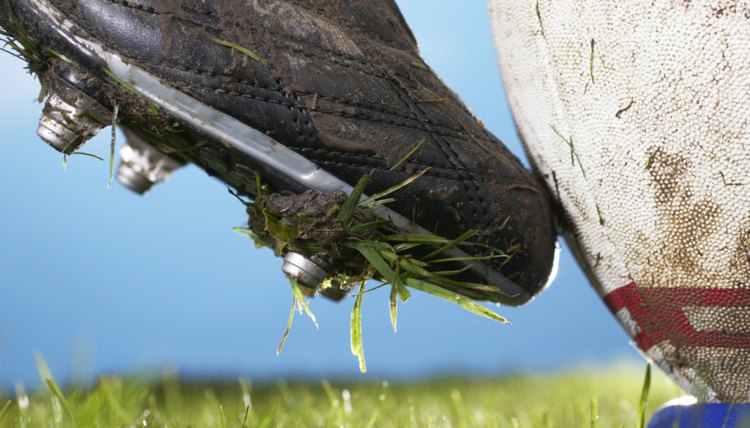What Different Kinds of Sports Have Specialized Shoes?

The shoes you wear when playing sports can make the difference between a successful experience and discomfort or injury. Each sport has particular requirements for footwear. When you purchase or rent shoes specially geared toward a sport, consider a specialty sports shoe store that is recommended by a sports podiatrist or other athletes. Trained staff at such stores can help you choose shoes that best fit your needs.
Cleats, Studs and Spikes
Sports that are played on grass or turf usually require shoes that have cleats, studs or spikes. Baseball, football, golf and soccer are examples. The arrangement of the cleats vary between sporting activities, but the cleats are usually either connected to the nylon soles of the shoes or are removable and replaceable. Gel shoe inserts can help make cleated shoes feel less jarring as you run.
Running
Aerobic sports like track and court-based sports such as basketball and tennis require comfortable, flexible shoes with strong support and shock absorption. Athletes who use running shoes are required to make sudden movements in all directions. These movements cause running shoes to wear out quicker than other types of sports shoes. Running shoes should be replaced every nine to 12 months, since shoes lose over half of their shock absorbency ability between 250 and 500 miles of running.
Gymnastics
Each gymnastic event, such as floor exercises, rings, or parallel bars, requires its own type of footwear. For some events you can use standard tennis shoes, and others allow or encourage athletes to be barefoot during the sport. Your level of experience and the type of surface on which you perform helps determine what type of shoe is appropriate. Talk with your coach or trainer about which type of shoe you should have.
Shoes with Equipment
Sports performed in snow or on ice, such as skiing, skating, hockey and snowboarding, usually require shoes or boots that fasten into other equipment. Ice skates have a blade built into the bottom of the athlete’s footwear, and skis and snowboards often have bindings into which a shoe or boot is placed. Insulation, padding and thermal socks are important in winter sport footwear to protect your toes and feet from frostbite.
Precautions
When buying sports shoes, try them on at the end of the day or after participating in your sport. This is when your feet are the largest, and will give an accurate assessment of how the shoes will feel while engaging in activity. Check your shoes regularly for uneven or excessive wear, which can lead to painful shin splints.
References
- University of California San Diego: Athletic Shoes: Find the Right Shoe for You
- American Academy of Orthopaedic Surgeons: Athletic Shoes
- American Academy of Orthopaedic Surgeons: Tips for a Safe Running Program
- American Academy of Orthopaedic Surgeons: Gymnastics Injury Prevention
- The University of Utah: Backcountry Ski Bindings
- Drugs.com: Health Tip: Prevent Shin Splints
Writer Bio
Susan Presley has worked in health care journalism since 2007, and has been published in the American Journal of Nursing and other academic periodicals. She received her Bachelor of Arts from Truman State University and a Master of Divinity degree from Louisville Presbyterian Theological Seminary.
